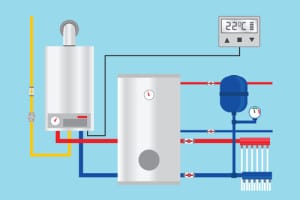
More than 10 million sensors, plus gateways, a cloud computing platform, and business intelligence software will help save $42 million in hot water heating costs across multiple apartment buildings.
Name of Organization: Stockrose
Industry: Property management
Location: Stockholm, Sweden
Opportunity or Challenge Encountered:
In Sweden, energy is in high demand in the winter, and for the country’s many apartment dwellers, hot water is the third major expense for buildings after heating and cooling. Typically, however, monitoring hot water consumption has been a hit-or-miss proposition. Furthermore, cutting energy use is much more complicated for apartment building owners than it is for single-family homeowners, who would see immediate savings as a result of a single change, such as taking shorter showers. Apartment owners typically lack effective ways to monitor and influence the energy consumption of individual tenants.
Stockrose, a Swedish property management company with approximately 2.5 million apartments under management, needed an efficient approach to reduce energy consumption from water heaters. For starters, as documented in a recent Microsoft case study, the company sought to cut hot water use, the top energy expense after heating and cooling. Hot water use accounts for about 20 percent of the energy bill in single-family homes and reaches a much higher percentage in apartment buildings.
Hot water heater energy efficiency
Reducing hot water consumption is challenging, since building owners can’t determine which apartments are using more hot water than others. As a result, owners typically have to distribute utility costs equally between tenants. With some tenants paying for more than their share of hot water, there’s little incentive for anyone to conserve.
Stockrose needed a way to connect smart sensors for remote, real-time monitoring of water usage. The challenge was sheer scale – each of the company’s 2.5 million apartments required a minimum of five sensors each. Along with an enormous number of sensors, each building also includes systems from multiple manufacturers for water, electricity, plumbing, heating, and air conditioning.

Stockrose teamed with Denmark’s Eniga—a provider of intelligent cloud solutions—to convert its hundreds of structures into energy-efficient “smart buildings” with Microsoft Azure, a cloud computing platform, according to the case study. The smart buildings-as-a-service offering would be based on a platform to connect sensors in apartment buildings to IoT gateway devices running on-premises. The vendor employed the Azure IoT Gateway SDK to connect with gateways from diverse vendors to send data to the cloud.
The gateways integrate with cloud services, including Microsoft Azure IoT Hub, Azure App Services, Azure DocumentDB, and Azure SQL Database. The solution also uses Microsoft Dynamics 365 to manage customer and tenant information, and publishes alerts and reports to customers through a Microsoft Power BI dashboard that can be accessed through PCs and mobile devices.
The team began their effort by tracking hot water usage, and the hybrid on-premises and cloud infrastructure connects at least five sensors in each apartment unit to the cloud. Other services then process and analyze sensor data to provide building owners with insights into resource usage. Azure IoT Hub ingests data from the millions of sensors in buildings connected through the gateways. This gives Stockrose the flexibility to bring smart buildings online quickly and affordably without ripping and replacing existing infrastructure.
Stockrose can connect an apartment to the cloud in approximately 20 minutes. In addition to monitoring hot water consumption, the platform can also detect water leaks.
Benefits From This Initiative:
As a result of the IoT-based monitoring implementation, Stockrose property owners may save an estimated $42 million in hot water costs within 10 years, the case study states. Plus, the company has been able to shed the old model of dividing utility costs equally between tenants to a model where those who consume less, pay less.
Plus, the platform can easily extend to other equipment, sensors, and buildings, to further predictive maintenance capabilities via real-time analytics. Stockrose’s IoT platform can connect to all of a building’s systems, from HVAC to solar panels. It can also measure the snowpack on roofs to help avoid costly damage and insurance claims. Another benefit is that it opens opportunities for Stockrose to offer new products to property owners, such as water-saving shower fixtures and appliances.
With predictive maintenance capabilities, sensors can be installed on buildings to gauge the need for snow removal – replacing the current process of sending an individual up to look at it. In the future, the platform will be able to connect with virtually every system in the building, from HVAC systems to rooftop solar panels.
“You can make your tenants more aware and separate out the utilities cost from the rent so that people who use less hot water pay less money,” says Richard Lind, chief executive officer at Stockrose, is quoted in the case study. “As a tenant, I’m motivated to look at my environmental footprint, and I will have a financial incentive, for example, to conserve water by taking a shower instead of a bath.”
(Source: Microsoft)





























